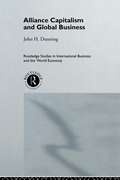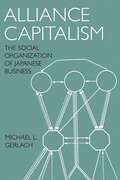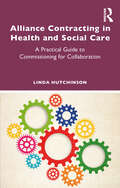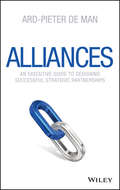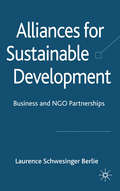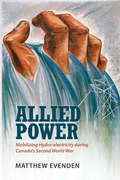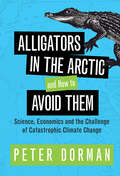- Table View
- List View
Allgemeine Betriebswirtschaftslehre: Umfassende Einführung aus managementorientierter Sicht
by Jean-Paul Thommen Ann-Kristin AchleitnerDieses bewährte Lehrbuch gibt eine umfassende und sehr gut verständliche Einführung in alle unternehmerischen Funktionen aus managementorientierter Sicht.Die klare Strukturierung des Inhalts, die vielen anschaulichen Grafiken sowie das umfangreiche Stichwortverzeichnis ermöglichen auch eine Nutzung des Lehrbuches als Nachschlagewerk.Neu in der 7. AuflageFür die 7. Auflage wurde der Lehrbuch-Bestseller erneut überarbeitet und aktualisiert. Insbesondere wurde im Teil „Rechnungswesen“ das Kapitel zur Rechnungslegung nach HGB an die Änderungen der Gesetzgebung angepasst, welche sich durch das im Jahr 2009 in Kraft getretene Bilanzrechtsmodernisierungsgesetz ergeben haben. Die Kapitel „Informationsmanagement“, „Projektmanagement“ und „Risikomanagement“ wurden gestrichen, da diese Themen sich für eine Allgemeine Betriebswirtschaftslehre als zu spezifisch erwiesen haben.
Allgemeine Wirtschaftspolitik: Editiert und herausgegeben von Karen Horn, Karl-Heinz Paqué und Lars P. Feld (Herbert Giersch. Gesammelte Schriften)
by Herbert GierschIn diesem zweiten Band der „Allgemeinen Wirtschaftspolitik“ liefert Herbert Giersch ein Kompendium des konjunkturpolitischen Wissens seiner Zeit, das noch heute fasziniert. Es vereinigt die Erkenntnisse volkswirtschaftlicher Theorie und wirtschaftspolitischer Praxis, die der Autor in eineinhalb Jahrzehnten der universitären Lehre und Forschung sowie der Tätigkeit als akademischer Berater für sich erschlossen und weitergegeben hat. Damit umfasst es ein riesiges Spektrum von Themen, die in den sechziger und siebziger Jahren auf der Tagesordnung standen. Der Zusammenbruch des Bretton-Woods-Systems und der erste Ölpreisschock lagen bei Erstveröffentlichung dieses Bandes gerade einmal vier Jahre zurück. Damit endete die Phase dynamischen industriegetriebenen Wachstums, die Deutschland nach Auslaufen des Wirtschaftswunders Vollbeschäftigung bei starker Zuwanderung beschert hatte. Das Buch enthält alles, was Giersch vor diesem Hintergrund in der Auseinandersetzung mit Denkrichtungen vom Keynesianismus über die Neoklassik bis zum Monetarismus zu sagen hat.
Allgemeine Wirtschaftspolitik: Editiert und herausgegeben von Karen Horn, Karl-Heinz Paqué und Lars P. Feld (Herbert Giersch. Gesammelte Schriften)
by Herbert GierschIn diesem ersten Band der „Allgemeinen Wirtschaftspolitik“ vermittelt Herbert Giersch ein bis heute essenzielles Stück staatsbürgerlichen Wissens. Zugleich stellt dieses Buch ein faszinierendes Dokument der wirtschaftspolitischen und intellektuellen Zeitgeschichte dar. Tiefe ökonomische, sozialphilosophische und wissenschaftstheoretische Erkenntnis schlägt sich darin nieder. Der Autor behandelt Wesen, Ziele, Konflikte, Konzeptionen und Institutionen der Wirtschaftspolitik, den Beitrag der Ökonomik und insbesondere der Wohlfahrtstheorie. Philosophische, politische und ökonomische Perspektive vereinend, widmet er auch den bis heute prägenden Denkgebäuden der Wirtschaftspolitik viel Raum, vom Merkantilismus über den klassischen Liberalismus und den Marxismus bis hin zum Neoliberalismus und zur sozialen Marktwirtschaft. Darüber hinaus schildert er den Weg zur praktischen Umsetzung wirtschaftspolitischer Vorschläge innerhalb der Willensbildungsprozesse pluralistischer demokratischer Gesellschaften.
Alliance Capitalism and Global Business (Routledge Studies in International Business and the World Economy #No.7)
by John H. Dunning Professor John DunningJohn Dunning is the leading authority in the field of international business. His latest work analyses: * future developments in global business * a comparison of US and Japanese investment in Europe * competitiveness, trade and integration * spatial dimensions of globalization
Alliance Capitalism, Innovation and the Chinese State: The Global Wireless Sector (International Political Economy Series)
by Victoria HigginsThis book analyses how key 'systems integration' technical pressures, and the increasing use of collaborative alliances for market and product development are impacting on the socio technical policy directives of Chinese State leaders and the strategic behaviour of key Chinese high technology firms operating in the global wireless sector.
Alliance Capitalism: The Social Organization of Japanese Business
by Michael L. GerlachBusiness practices in Japan inspire fierce and even acrimonious debate, especially when they are compared to American practices. This book attempts to explain the remarkable economic success of Japan in the postwar period—a success it is crucial for us to understand in a time marked by controversial trade imbalances and concerns over competitive industrial performance.Gerlach focuses on what he calls the intercorporate alliance, the innovative and increasingly pervasive practice of bringing together a cluster of affiliated companies that extends across a broad range of markets. The best known of these alliances are the keiretsu, or enterprise groups, which include both diversified families of firms located around major banks and trading companies and vertical families of suppliers and distributors linked to prominent manufacturers in the automobile, electronics, and other industries. In providing a key link between isolated local firms and extended international markets, the intercorporate alliance has had profound effects on the industrial and social organization of Japanese businesses.Gerlach casts his net widely. He not only provides a rigorous analysis of intercorporate capitalism in Japan, making useful distinctions between Japanese and American practices, but he also develops a broad theoretical context for understanding Japan's business networks. Addressing economists, sociologists, and other social scientists, he argues that the intercorporate alliance is as much a result of overlapping political, economic, and social forces as are such traditional Western economic institutions as the public corporation and the stock market.Most compellingly, Alliance Capitalism raises important questions about the best method of exchange in any economy. It identifies situations where cooperation among companies is an effective way of channeling corporate activities in a world marked by complexity and rapid change, and considers in detail alternatives to hostile takeovers and other characteristic features of American capitalism. The book also points to the broader challenges facing Japan and its trading partners as they seek to coordinate their distinctive forms of economic organization.
Alliance Contracting in Health and Social Care: A Practical Guide to Commissioning for Collaboration
by Linda HutchinsonAlliance Contracting in Health and Social Care is a ground-breaking and practical guide to collaborating and co-ordinating service provision across different providers, taking readers through each step from initial concept to launch and operation.Responding to the need for more joined up services, the book explains how alliancing and alliance contracting can tackle the system issues which often stymie collaboration between different agencies. It takes a people-centred approach providing guidance for the legal, financial and governance frameworks needed for organisations to work together, ultimately providing better health and social care. Written by a leading expert in the field, it also features detailed examples of where alliancing has already proved successful, including services around mental health and homelessness in different regions of the UK.This important book will be essential reading for anyone commissioning services across the health and social care sector, in both the UK and beyond.
Alliances
by Ard-Pieter de ManA timely and practical guide that helps senior managers design successful strategic partnershipsStrategic alliances are increasingly common among modern corporations and a hot topic in today's business schools. Alliance is a sophisticated guide to crafting successful partnerships, offering a combination of carefully designed checklists, up-to-date examples and scenarios from around the world, and the tools needed to ensure that all elements of an alliance are taken into account and fully assessed. Most managers don't have the experience or knowledge to create a functional alliance governance structure. This book fills that knowledge gap with a clear description of the proper implementation process.Ideal for business leaders engaged in building a corporate alliance and business school studentsCovers all of the available alliance structure, describes the building blocks of alliance design, and defines an effective process for managers constructing alliancesWritten by a leading expert on the subject who is a member of the Board of Directors of the Association of Strategic Alliance ProfessionalsAs the popularity and frequency of corporate strategic alliances grows, Alliance gives business leaders the insight and practical advice they need to ensure their partnerships benefit all parties.
Alliances for Sustainable Development: Business and NGO Partnerships
by Laurence Schwesinger BerlieA lively and hands-on exploration of corporate-NGO alliances. It offers original insight to understand why alliances exist and to what end. It also looks into the asymmetries between partners and dwells on three crucial aspects of alliances management : alliance capacity development, stakeholder involvement and alliance metrics.
Allianz (A1): An Insurer Acquiring a Bank?
by Joseph L. Bower Anders Sjoman Sonja Ellingson Hout Marc L. BertonecheThe deal of the year in 2002, was the acquisition of Dresdner Bank by Allianz. Written from the perspectives of Allianz's CEO, Henning Schulte-Noelle, before and after the deal and a regional manager implementing the concept of a full-line financial service provider. Presents the original question facing Schulte-Noelle: "Should Allianz acquire Dresdner?"
Allianz Customer Centricity: Is Simplicity the Way Forward?
by Emilie Billaud Eva AscarzaThis case explores the tradeoffs between product personalization and simplicity as companies grow. The case presents an opportunity to understand whether and how each of these approaches enables and/or limits companies' abilities to provide customer satisfaction while being efficient in their operations. In October 2018, Allianz was one of the world's leading insurers and asset managers with 103 million retail and corporate customers in 70 countries. It was one of only two insurers to rank amongst the world's 50 strongest brands in 2017, a sign that the company's customer-centricity approach drove value and resonated with clients. Allianz's ambition was to reach the top 25 brands in Interbrand's ranking by 2025. For the insurer, the key to success was to focus on simplicity-reducing the complexity of products and processes in order to create a more unified customer experience. However, such a move did not align with current trends in insurance markets, where Allianz's main competitors had opted for hyper-personalization. Furthermore, a strategy focused on simplicity implied a radical move in certain key markets where Allianz had traditionally offered a large diversity of products. Was simplicity the right strategy? Would Allianz be able to embrace customer needs successfully within and across markets while simultaneously growing its business?
Allianz Turkey: Focus on the Customer (A)
by W. Earl Sasser Jr. Gamze YucaogluAt the age of 39, Solmaz Alt n took over the helm at Allianz Turkey. Solmaz quickly realized that, although the insurance market was thinly penetrated in Turkey, the company was operating in a very competitive environment with pressure on prices and, hence, cost control. Consequently, customer satisfaction was suffering. Despite the growing Turkish economy and a favorable regulatory environment, Solmaz was struggling to grow the company without further sacrificing customer satisfaction or profitability. Used as part of a course on service excellence, the case provides an insurance context in which to explore the link between customer satisfaction and competitive performance and challenges the students to ponder the extent of the relationship between customer satisfaction and financial performance. In the (A) case, the Allianz Turkey executives focus their initial efforts on the claims process of the automobile insurance business-a lowly rated segment of the insurance industry by their policyholders. They begin by creating a map of the customer experience and then doing extensive consumer research to determine what really matters to the policyholder. The insights gleaned from the detailed consumer analysis are quite different than the original beliefs of the management team. Students must devise a new customer service model for the claims process based upon the customer analysis. The (B) case describes the new customer service model for the claims process and the resulting increase in customer satisfaction as measured by the Net Promoter Score (NPS) metric. Students must first decide whether the initial effort is a success and then develop a plan for the future.
Allianz Turkey: Focus on the Customer (A)
by W. Earl Sasser Jr. Gamze YucaogluAt the age of 39, Solmaz Alt n took over the helm at Allianz Turkey. Solmaz quickly realized that, although the insurance market was thinly penetrated in Turkey, the company was operating in a very competitive environment with pressure on prices and, hence, cost control. Consequently, customer satisfaction was suffering. Despite the growing Turkish economy and a favorable regulatory environment, Solmaz was struggling to grow the company without further sacrificing customer satisfaction or profitability. Used as part of a course on service excellence, the case provides an insurance context in which to explore the link between customer satisfaction and competitive performance and challenges the students to ponder the extent of the relationship between customer satisfaction and financial performance. In the (A) case, the Allianz Turkey executives focus their initial efforts on the claims process of the automobile insurance business-a lowly rated segment of the insurance industry by their policyholders. They begin by creating a map of the customer experience and then doing extensive consumer research to determine what really matters to the policyholder. The insights gleaned from the detailed consumer analysis are quite different than the original beliefs of the management team. Students must devise a new customer service model for the claims process based upon the customer analysis. The (B) case describes the new customer service model for the claims process and the resulting increase in customer satisfaction as measured by the Net Promoter Score (NPS) metric. Students must first decide whether the initial effort is a success and then develop a plan for the future.
Allianz Turkey: Focus on the Customer (B)
by W. Earl Sasser Jr. Gamze YucaogluAt the age of 39, Solmaz Alt n took over the helm at Allianz Turkey. Solmaz quickly realized that, although the insurance market was thinly penetrated in Turkey, the company was operating in a very competitive environment with pressure on prices and, hence, cost control. Consequently, customer satisfaction was suffering. Despite the growing Turkish economy and a favorable regulatory environment, Solmaz was struggling to grow the company without further sacrificing customer satisfaction or profitability. Used as part of a course on service excellence, the case provides an insurance context in which to explore the link between customer satisfaction and competitive performance and challenges the students to ponder the extent of the relationship between customer satisfaction and financial performance. In the (A) case, the Allianz Turkey executives focus their initial efforts on the claims process of the automobile insurance business-a lowly rated segment of the insurance industry by their policyholders. They begin by creating a map of the customer experience and then doing extensive consumer research to determine what really matters to the policyholder. The insights gleaned from the detailed consumer analysis are quite different than the original beliefs of the management team. Students must devise a new customer service model for the claims process based upon the customer analysis. The (B) case describes the new customer service model for the claims process and the resulting increase in customer satisfaction as measured by the Net Promoter Score (NPS) metric. Students must first decide whether the initial effort is a success and then develop a plan for the future.
Allied Power
by Matthew EvendenCanada emerged from the Second World War as a hydro-electric superpower. Only the United States generated more hydro power than Canada and only Norway generated more per capita. Allied Power is about how this came to be: the mobilization of Canadian hydro-electricity during the war and the impact of that wartime expansion on Canada's power systems, rivers, and politics.Matthew Evenden argues that the wartime power crisis facilitated an unprecedented expansion of state control over hydro-electric development, boosting the country's generating capacity and making an important material contribution to the Allied war effort at the same time as it exacerbated regional disparities, transformed rivers through dam construction, and changed public attitudes to electricity though power conservation programs.An important contribution to the political, environmental, and economic history of wartime Canada, Allied Power is an innovative examination of a little-known aspect of Canada's Second World War experience.
Allies and Advocates: Creating an Inclusive and Equitable Culture
by Amber CabralLearn to create an inclusive environment with this actionable and insightful resource Allies and Advocates: Creating an Inclusive and Equitable Culture delivers a powerful and useful message about inclusion and diversity in everyday life. Author Amber Cabral, a celebrated inclusion strategist, speaker, and writer, shows readers how to move away from discriminatory and unjust behaviors to supporting and building meaningful connections with people across our diverse backgrounds and identities. While some books settle for vague advice and catchphrases, readers of Allies and Advocates will benefit from the book’s: Straightforward style and applicable action items Real-world examples highlighting inclusion best practices Implementable tactics to assist people in seeing how they can help create an inclusive environment Perfect for anyone who works in a professional environment, Allies and Advocates is especially useful for those in middle and upper management and those involved in the training and orientation of employees. If you are looking forward to building a culture of inclusivity at work or in your personal relationships, and want to learn how to use your privilege to be a better ally, Allies and Advocates: Creating an Inclusive and Equitable Culture is a must-have.
Allies or Adversaries
by Jennifer N. BrassGovernments throughout the developing world have witnessed a proliferation of non-governmental, non-profit organizations (NGOs) providing services like education, healthcare and piped drinking water in their territory. In Allies or Adversaries, Jennifer N. Brass explains how these NGOs have changed the nature of service provision, governance, and state development in the early twenty-first century. Analyzing original surveys alongside interviews with public officials, NGOs and citizens, Brass traces street-level government-NGO and state-society relations in rural, town and city settings of Kenya. She examines several case studies of NGOs within Africa in order to demonstrate how the boundary between purely state and non-state actors blurs, resulting in a very slow turn toward more accountable and democratic public service administration. Ideal for scholars, international development practitioners, and students interested in global or international affairs, this detailed analysis provides rich data about NGO-government and citizen-state interactions in an accessible and original manner.
Alligators in the Arctic and How to Avoid Them: Science, Economics and the Challenge of Catastrophic Climate Change
by Peter DormanClimate change is a matter of extreme urgency. Integrating science and economics, this book demonstrates the need for measures to put a strict lid on cumulative carbon emissions and shows how to implement them. Using the carbon budget framework, it reveals the shortcomings of current policies and the debates around them, such as the popular enthusiasm for individual solutions and the fruitless search for 'optimal' regulation by economists and other specialists. On the political front, it explains why business opposition to the policies we need goes well beyond the fossil fuel industry, requiring a more radical rebalancing of power. This wide-ranging study goes against the most prevalent approaches in mainstream economics, which argue that we can tackle climate change while causing minimal disruption to the global economy. The author argues that this view is not only impossible, but also dangerously complacent.
Allocating Decision Rights & Accountability: Elements of Effective IT Governance
by Jeanne W. Ross Peter WeillEvery firm, at some level, needs a digitized platform, or integrated set of electronic business processes, to operate effectively. The only way to deliver a digitized platform--and superior business value from IT--is to design IT decision rights and accountabilities so that daily decisions about IT support the firm's strategic goals. In this chapter, the authors explain the importance of transparency in IT governance and describe how a firm's governance mechanisms clarify how each of five key decisions will be made and who will be held accountable. Having a clear direction in each of the five decision areas will help promote desirable behavior in the management and the use of IT. This chapter was originally published as chapter 5 of "IT Savvy: What Top Executives Must Know to Go from Pain to Gain."
Allocating Pensions to Younger People: Towards a Social Insurance against a Short Life
by Gregory PonthiereThis book takes as a starting point that welfare states in developed societies do not provide systems of social insurance against the risk of an early death. In contrast to the way in which economically developed countries provide ways of insuring citizens against other possibilities, such as unemployment and disease, no such social insurance mechanism exists for early death. It aims to demonstrate that, despite the impossibility to compensate the victims of a short life once they are identified, and despite the impossibility to identify the persons who will be short-lived (when they are still alive), it is nonetheless possible to construct a social insurance against the risk of a short life by means of age-based statistical discrimination favouring all young persons. Combining philosophical literature with economic analysis, the book re-examines the ethical foundations of social insurance, and proposes a major reform of the welfare state: the construction of a social insurance against a short life. It shows how such an insurance system could be constructed by partially ‘reversing’ existing pension systems, by offering a period of retirement to all young adults before they start their career. Such a ‘reversed’ pension system would allocate more free time and opportunities to younger members of society before they enter the labour market, and, hence, this system would also improve the lives of the – unidentified – young persons who will turn out to die prematurely. The book discusses the social desirability of this new system, as well as its financial feasibility and societal consequences, examining how pension allowances paid to young adults may be financed by the work of senior workers. As such, this book demonstrates how the universal uncertainty about the duration of life can be reconciled with the idea of social justice. With an accessible and interdisciplinary approach, this book will be of interest to academics working in a range of fields, including economics, public finance, social insurance, the economics of ageing and the welfare state, economic ethics and political philosophy.
Allocation in Networks
by Jens Leth HougaardA comprehensive overview of networks and economic design, presenting models and results drawn from economics, operations research, and computer science; with examples and exercises. This book explores networks and economic design, focusing on the role played by allocation rules (revenue and cost-sharing schemes) in creating and sustaining efficient network solutions. It takes a normative approach, seeking economically efficient network solutions sustained by distributional fairness, and considers how different ways of allocating liability affect incentives for network usage and development. The text presents an up-to-date overview of models and results currently scattered over several strands of literature, drawing on economics, operations research, and computer science. The book's analysis of allocation problems includes such classic models from combinatorial optimization as the minimum cost spanning tree and the traveling salesman problem. It examines the planner's ability to design mechanisms that will implement efficient network structures, both in large decentralized networks and when there is user-agent information asymmetry. Offering systematic theoretical analyses of various compelling allocation rules in cases of fixed network structures as well as discussions of network design problems, the book covers such topics as tree-structured distribution systems, routing games, organizational hierarchies, the “price of anarchy,” mechanism design, and efficient implementation. Appropriate as a reference for practitioners in network regulation and the network industry or as a text for graduate students, the book offers numerous illustrative examples and end-of-chapter exercises that highlight the concepts and methods presented.
Alloy.com: Marketing to Generation Y
by John Deighton Gil McwilliamsA profitable dot com company? Alloy.com retails clothing to teens by catalog. Alloy uses a Web site to convert prospects and build community. The result is a business with the economics of a direct marketer and the market capitalization of an Internet start-up. The case presents the decision of whether to partner with AOL or to persevere with the current mix of customer acquisition methods.
Allstate Corporation, 2007-2013
by John R. Wells Galen DanskinAfter five years of global financial crises and natural catastrophes, Allstate, the USA's number two property and casualty insurer, seemed to be on the mend. It had been a tough ride for Thomas Wilson who had taken over as CEO on January 1, 2007 and vowed to "reinvent protection and retirement for the consumer." Soon after this statement, combination of exogenous shocks and fierce competition had driven the whole industry into underwriting losses. Meanwhile, Allstate continued to lose market share to GEICO and Progressive as it struggled to build its direct sales business in the face of opposition from its tied-agent distribution system. During the May 2011 Annual General Meeting (AGM), 31% of shareholders voted against Wilson's reappointment, the highest "no" vote for any CEO in the Standard & Poor's 500. Many speculated that he would not last long. To help boost direct sales, in October 2011, Wilson completed the acquisition of Esurance, a direct online specialist with a 2% share of online sales. In the next six months, Allstate's stock price rose 45%, buoyed by Wilson's promise that return on equity would reach 13% by 2014. At the May 2012 AGM, Wilson's support from shareholders surged to 97%. By the end of 2012, revenues were up 2% to $33.3 billion while operating profits surged 168% to $3.6 billion. With renewed support, Wilson pondered on what else he might do to ward off the challenges from GEICO and Progressive.
Alltagscoaching 360°: Private und berufliche Selbststärkung von A - Z
by Anette Schunder-HartungDas Buch stellt in Essayform 85 sorgfältig aufbereitete Lebensthemen zum Selbststudium zusammen: von A – Z, zum Lesen, Nachschlagen und zum praktischen Nachvollziehen. Dabei kommen Herausforderungen aus unserer persönlichen Sphäre ebenso zum Tragen wie besondere Aspekte unseres Arbeitslebens.Um Ihnen einen raschen Überblick zu verschaffen, sind die einzelnen Abschnitte je nach Schwerpunkt als privat oder beruflich gekennzeichnet. Bestimmte Grundsatzfragen wie Liebe und Respekt, das männliche und weibliche Prinzip in Yin und Yang, der Umgang mit Krankheiten und schließlich das große Thema Zukunft werden besonders ausführlich erörtert. Für Motivationskrisen bekommen Sie eine leicht zu merkende Soforthilfe-Formel. Ein System von Verweispfeilen unterstützt Sie beim Vertiefen wiederkehrender Alltagsfragen. Kurze, prägnante Leitsätze können Sie am Schluss des Buches mit eigenen Anmerkungen verbinden. Ein umfangreiches Literaturverzeichnis aus öffentlich zugänglichen Quellen rundet Ihre Lektüre ab.
Alltagsentscheidungen: Die anderen sind nicht dümmer als wir
by Klaus SchredelsekerDieses Buch besch#65533;ftigt sich mit Entscheidungen, aber es ist kein Buch #65533;ber Entscheidungstheorie, wenngleich ab und zu auch auf entscheidungstheoretische Konzeptionen Bezug genommen wird. Es ist ein Buch #65533;ber die Allt#65533;glichkeit von Entscheidungen, pr#65533;sentiert anhand von 99 h#65533;chst unterschiedlichen Episoden, trivialen und weniger trivialen. Viele Menschen haben Schwierigkeiten mit selbstreflexiven Problemen, bei denen es nicht nur um das eigene Problemverst#65533;ndnis, sondern vor allem um das anderer Personen geht (Mehrpersonenentscheidungen, Spiele, M#65533;rkte). Der Autor hat #65533;ber die Jahre eine F#65533;lle derartiger Probleme gesammelt und in diesem Buch zusammengetragen. Es geht um Denkfehler, asymmetrische Informationen und Signalling. Formuliert anhand praxiserprobter Beispiele, die jeder von uns aus dem Alltag kennt.



